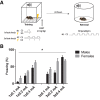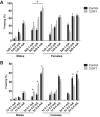Effects of corticosterone on mild auditory fear conditioning and extinction; role of sex and training paradigm
- PMID: 30224557
- PMCID: PMC6149954
- DOI: 10.1101/lm.047811.118
Effects of corticosterone on mild auditory fear conditioning and extinction; role of sex and training paradigm
Abstract
Multiple lines of evidence suggest that glucocorticoid hormones enhance memory consolidation of fearful events. However, most of these studies involve male individuals. Since anxiety, fear, and fear-associated disorders present differently in male and female subjects we investigated in mice whether male and female mice perform differently in a mild, auditory fear conditioning task and tested the modulatory role of glucocorticoid hormones. Using an auditory fear conditioning paradigm with different footshock intensities (0.1, 0.2, and 0.4 mA) and frequencies (1× or 3×), we find that intraperitoneal injections with corticosterone (2 mg/kg) immediately after training, altered freezing behavior when repeated footshocks were applied, and that the direction of the effects were opposite in male and female mice. Effects were independent of footshock intensity. In male mice, corticosterone consistently increased freezing behavior in response to the tone, whereas in female mice, corticosterone reduced freezing behavior 24 h after training. These effects were not related to the phase of the oestrous cycle. In addition, corticosterone enhanced extinction learning for all tones, in both male and female mice. These results emphasize that glucocorticoid hormones influence memory consolidation and retrieval, and underscore sex-specific effects of glucocorticoid hormones in modulating conditioned fear responses.
© 2018 Lesuis et al.; Published by Cold Spring Harbor Laboratory Press.
Figures



Similar articles
-
Chronic stress and sex differences on the recall of fear conditioning and extinction.Neurobiol Learn Mem. 2009 Mar;91(3):323-32. doi: 10.1016/j.nlm.2008.11.005. Epub 2009 Jan 6. Neurobiol Learn Mem. 2009. PMID: 19073269 Free PMC article.
-
Knockdown of corticotropin-releasing factor 1 receptors in the ventral tegmental area enhances conditioned fear.Eur Neuropsychopharmacol. 2016 Sep;26(9):1533-1540. doi: 10.1016/j.euroneuro.2016.06.002. Epub 2016 Jul 7. Eur Neuropsychopharmacol. 2016. PMID: 27397862
-
Estrous cycle phase and gonadal hormones influence conditioned fear extinction.Neuroscience. 2009 Dec 15;164(3):887-95. doi: 10.1016/j.neuroscience.2009.09.011. Epub 2009 Sep 15. Neuroscience. 2009. PMID: 19761818 Free PMC article.
-
Early-life stress impairs acquisition and retrieval of fear memories: sex-effects, corticosterone modulation, and partial prevention by targeting glucocorticoid receptors at adolescent age.Neurobiol Stress. 2024 Apr 23;31:100636. doi: 10.1016/j.ynstr.2024.100636. eCollection 2024 Jul. Neurobiol Stress. 2024. PMID: 38883213 Free PMC article. Review.
-
Sex differences in fear extinction.Neurosci Biobehav Rev. 2019 Aug;103:81-108. doi: 10.1016/j.neubiorev.2019.05.020. Epub 2019 May 23. Neurosci Biobehav Rev. 2019. PMID: 31129235 Free PMC article. Review.
Cited by
-
Effects of Septin-14 Gene Deletion on Adult Cognitive/Emotional Behavior.Front Mol Neurosci. 2022 Apr 29;15:880858. doi: 10.3389/fnmol.2022.880858. eCollection 2022. Front Mol Neurosci. 2022. PMID: 35571367 Free PMC article.
-
Cerebellar modulation of memory encoding in the periaqueductal grey and fear behaviour.Elife. 2022 Mar 15;11:e76278. doi: 10.7554/eLife.76278. Elife. 2022. PMID: 35287795 Free PMC article.
-
Enhanced Fear Memories and Altered Brain Glucose Metabolism (18F-FDG-PET) following Subanesthetic Intravenous Ketamine Infusion in Female Sprague-Dawley Rats.Int J Mol Sci. 2022 Feb 8;23(3):1922. doi: 10.3390/ijms23031922. Int J Mol Sci. 2022. PMID: 35163844 Free PMC article.
-
A proposed role for glucocorticoids in mediating dopamine-dependent cue-reward learning.Stress. 2021 Mar;24(2):154-167. doi: 10.1080/10253890.2020.1768240. Epub 2020 Jun 11. Stress. 2021. PMID: 32396486 Free PMC article.
-
Stress-induced changes in the molecular processes underlying fear memories: implications for PTSD and relevant animal models.Mol Psychiatry. 2025 May;30(5):2219-2227. doi: 10.1038/s41380-025-02910-8. Epub 2025 Jan 31. Mol Psychiatry. 2025. PMID: 39890919 Free PMC article. Review.
References
-
- Aerni A, Traber R, Hock C, Roozendaal B, Schelling G, Papassotiropoulos A, Nitsch RM, Schnyder U, de Quervain DJ-F. 2004. Low-dose cortisol for symptoms of posttraumatic stress disorder. Am J Psychiatry 161: 1488–1490. - PubMed
-
- Beiko J, Lander R, Hampson E, Boon F, Cain DP. 2004. Contribution of sex differences in the acute stress response to sex differences in water maze performance in the rat. Behav Brain Res 151: 239–253. - PubMed
-
- Bohus B. 1970. The medial thalamus and the opposite effect of corticosteroids and adrenocorticotrophic hormone on avoidance extinction in the rat. Acta Physiol Acad Sci Hung 38: 217–223. - PubMed
Publication types
MeSH terms
Substances
LinkOut - more resources
Full Text Sources
Other Literature Sources
